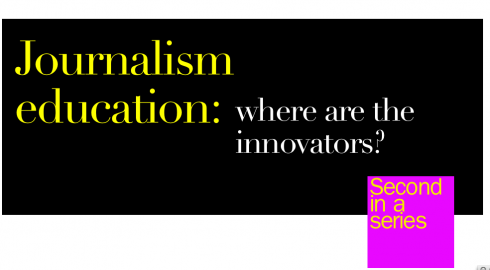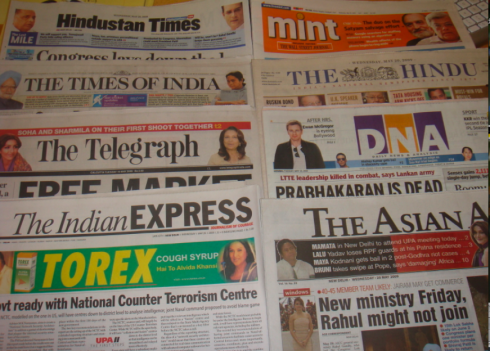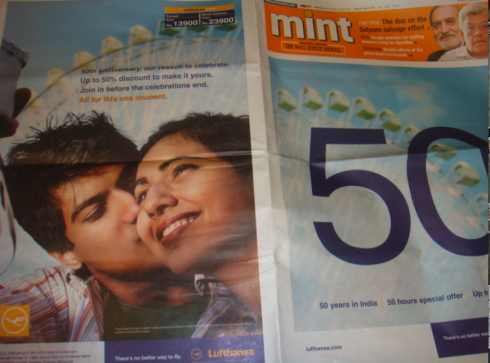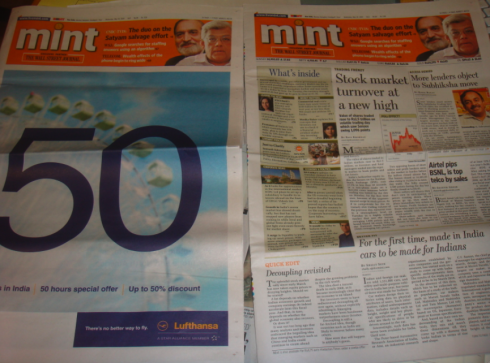
The School of Journalism at Universidad Catolica, in Santiago, Chile, is the only journalism school outside of the United States accredited by the ACJMC. They have held that honor for 10 years now. I have participated in their programs and had the honor to lecture at UC several years ago. It was there that I met one of the moving forces behind the success of UC, Prof. Eduardo Arriagada, with whom I have been in dialog the past few days as I know that his program is one we wanted to highlight here.
The key to the success of the UC program: very practical programs where students learn by doing. For example, the UC has a university daily newspaper sponsored through financing from Metro International as well as Microsoft: www.kilometrocero.cl. The newspaper provides workshops in writing, editing, graphic design, inforgraphics and illustration, where students edit other students’ work.
In addition, the emphasis, says Arriagada, is purely multi media. “We have varios radio programs, Internet radio, and an AM station that transmits programs 24 hours a day, all done by students. Next week the results of the work of a radio production class will be part of a new program of main radio in Chile that will be hosted by one of the most important radio presenters in the country.
. Students are behind every program, writing, editing, producing.” In terms of print publications, the UC students edit the Chilean edition of Rolling Stone Chile, as well as a second magazine, Paula, the Chilean Vanity Fair.
Television is also part of the multimedia training program at UC, with a news program devoted to national news, where they coordinate the work of 13 regional channels, as well as collaborating with CNN Chile, whose bureau is actually on campus, in an agreement similar to that carried out with Metro International. “The idea,” says Arriagada, ’ is that full time journalists are contracted to work with and to supervise the work of the students. Our emphasis is on making sure that the students who graduate, will have had real life experiences along the way.”

Prof. Arriagada is the author of a new book in Spanish, published by Editorial Catalonia, titled : “Blogs, medios tradicionales y nuevos medios en el Chile 2.0”
Mario: What specific courses do you have at both undergraduate and graduate levels addressing the issue of online journalism, storytelling in a multiplatform world?
Prof. Arraigada:
Because we work in a real media industry in our workshop-oriented media courses we deal with multimedia even if all of the courses begin only as traditional operations (press, radio and TV), but our special/required course is a workshop for developing how to inform in an interactive process, a full 2.0 course. We are developing a project in Facebook, an aplication, and this week we are beginning conversations with Dabiel Berdichevsky (author of a new book about Facebook psicology), an internet company and a big local Bank of Chile, to develop a new project that could finance the 2.0 workshop to begin in 2010. In this new space we need to explore the use of robots, links, to help moderation and to stimulate the audience to have major participation.All this is not new: personally, I am involved in this field as a consultant with former students that develop robots, with a regional newspaper from the north of the country building hyperlocal experiments with journalists blogs, etc.
Mario: How do you see UC carrying the banner for innovation in developing curriculum that anticipates the changes in the industry?
Prof. Arriagada:
I think that the advantage from the Faculty is the strong relation with the industry, I am sure that I haven’t seem something more robust than the relation we have had for decades. That explians that we work with leading and competitive media in all of our academic projects, we also hace a masters program in written journalism in an alliance with El Mercurio, that built a classroom in the middle of its newsroomm where the students make all the practice as part of the program. This relation explains the reason we are so worried by the business model crisis, but this has been an oppotunity also, because the media are looking again to the academics to ask, to discuss future ways of development and to ask for the work with students to make experimentations.
Mario:What are your models? Where else in Latin America are universities and colleges of journalism developing new curriculum?
Prof. Arriagada:
We use as benchmark several media schools from the United States, where we have the accreditation and we are always trying to take ideas from them. Columbia, NYU, Cuny at New York, Northwestern at Chicago, The Annebergs programas, Texas at Austin, Chappel Hill, etc. are the places where our professors go for their Ph.D’s and work for us as models. Also some British and Spanish programs,especially the University of Navarra’s and the one from the Autonoma de Barcelona. We don’t have strong relations with :Latinamerican programas, but there are strong bramds that we have contactcs with, as, for example, the PUC’s journalism program at Rio and Sao Paoulo, Brazil; the UCA and Austral universities at Buenos Aires, Argentina, the Monterrey Tec’s and the Iberoamerican programs in Mexico. We also have relations with the UPC at Perú. In Chile I need to mention the tradition of Universidad de Chile, specially now in the support of investigative journalism, a field that has good work in the Universidad Diego Portales program, too. I believe in the future of Universidad del Desarrollo and Universidad de Los Andes, two new programs that are making good initial progress. We have former students in charge in all these faculties at the moment.
Innovation and those Gannett guys have traditionally gone together. Remember, they gave us USAToday in 1985.
Now, Gannett faces its new challenge for innovation: going mobile. The goal: to transform its 900-plus publications, including the flagship USA TODAY®, from traditional printed formats into interactive, always-on digital media.
And, of course, it makes perfect sense that Gannett is taking the plunge into the mobile pool by embracing the iPhone. The company launched USA TODAY in the App Store, adding to Gannett’s ability to produce must-have news and information updated 24/7 for mobile users. The iPhone has helped redefine how it delivers content and advertising to consumers. I know, I have USAToday in my iPhone, and it is especially useful when I am far away from home, as this week, in India.
The Mobile Newsroom
The introduction of iPhone in the corporate enterprise was instrumental in Gannett’s mobile transformation. Gannett IT supports Microsoft Exchange Server and Exchange ActiveSync, so employees can use iPhone to get secure access to essential business information, including push email and calendar. iPhone also gives them mobile access to Gannett’s global address list of 41,000 employees.
Says Matt Jones, Vice President of Mobile Strategy and Operations, Gannett Digital:
“I’m on iPhone from 7 a.m. until 7 p.m., if not longer. The ability to access corporate email, my calendar, and address book on iPhone is absolutely critical.”
European newspapers are quickly reacting the same way. I know of at least three major daily newspapers in large European cities, now considering using the iPhone for similar purposes.
In India, one of the biggest world markets for mobile telephone use, the idea of mobile telephones and newspapers has not caught on yet. As an editor from the Hindustantimes of Delhi, tells me:
We are great mobile phone users, but we use phones primarily for conversation, text messaging and emails. iPhone penetration here has not been that great, and newspapers are not yet looking to mobile telephones for the type of applications that the Americans and Europeans are already well immersed into.
Letter from India: Indian readers trust their newspapers

Front pages from leading Indian newspapers today Wednesday

Entertainment daily supplements go all Bollywood


MINT, the financial daily, today devotes its page one to a full Lufthansa German Airlines ad, then the real front page is page 3. Lufthansa ad wraps around the newspaper.
This week I work with the team at Hindustantimes in Delhi. The newspaper has conducted extensive research prior to our lanching a totally new rethink of the HT, scheduled for late June.
What is fascinating to me, and should be for all of you who love newspapers, is that readers in focus groups in both Delhi and Mumbai, two of the most heavily populated Indian cities, and ranging in ages from 18 to 60 plus, had these comments to make:
1. Newspapers are the trusted medium for news and information. For example, if school closings are announced, and television and online have the information, readers will prefer to read newspapers for confirmation. Same applies to political and other news.
2. Loyalty is to the newspaper brand, but such loyalty is not there for television stations, for example. Readers would say that on any given story they might get it from three different television stations, but then they would go to their one newspaper of preference to confirm and to reassure themselves of the facts of the story.
3. Internet penetration is not that huge with the readers in the research, but obviously much more prevalent with the younger set (18-35), who also said that they go online for entertainment, more than for news and information.
Every time I spend a week in India, I am boosted tremendously when I see how newspapers are read by so many everywhere (one typical copy of an Indian newspaper may be shared by as many as 10 readers!), by the healthy amount of advertising on every page (something that has become a rarity elsewhere), and how there is a sort of reverence towards and a fascination with newspapers that ,unfortunately, we have lost in other parts of the world.
In case you have not seen an Indian newspaper: they are colorful birds, loud by most standards, and packed to the brim with news items. No story is too insignificant. For example, today’s fromt pages, almost all of them, show the body of Top Tiger, a legendary leader of Liberation TIgers of Tamil.
The daily entertainment supplements echo that one unforgettable Bollywood movie in your collection: a parade of beauty after beauty, colorful dresses,10 silhouetted photos minimum per page, big headlines, show biz, putting on the Ritz and not one millimeter of white space. And if the designer does not adhere to these rules, the page falls flat, the readers don’t like it and they tell you.
When in India, you go Bollywood, or you stay home.
And, yes, advertising starts on page one. Sometimes advertising IS page one, as is the case in today’s MINT, which offers its entire front page to Lufthansa German Airlines, celebrating 50 years of flights into India.
Follow the Marios

Two Marios. Two Views.
Follow Mario Jr. and his blog about media analysis, web design and assorted topics related to the current state of our industry.
http://garciainteractive.com/
Visit Mario Sr. daily here, or through TweetsByDesign (www.twitter.com/tweetsbydesign)
:
To read TheRodrigoFino blog, in Spanish, go:
https://garciamedia.com/latinamerica/blog/
TheMarioBlog posting #266